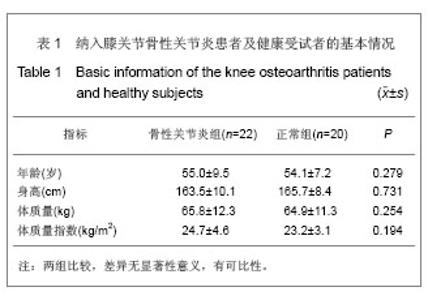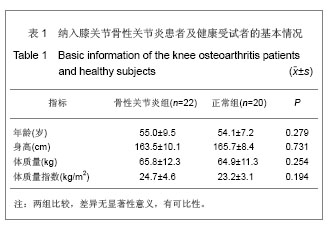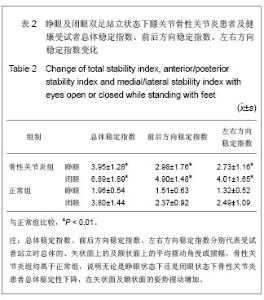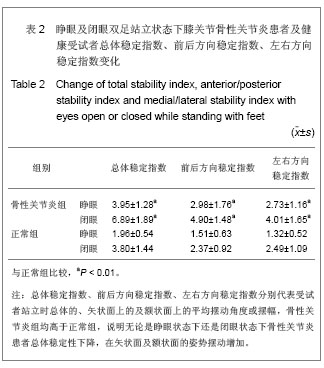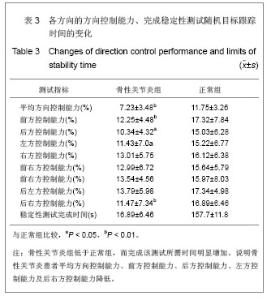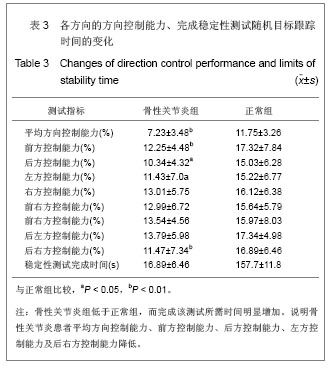| [1]Guo YM, Huang P, Chen W, et al. Zhongguo Kangfu Lilun yu Shijian. 2012;18(1):25-29.郭燕梅,黄鹏,陈蔚,等.老年单、双膝痛骨关节炎患者的平衡功能及其跌倒风险对比分析[J].中国康复理论与实践,2012, 18(1):25-29.[2]Zeng QY, Xu JC. Zhongguo Shiyong Neike Zazhi. 1998;18: 108-109.曾庆馀,许敬才.骨关节炎的分类诊断和流行病学[J].中国实用内科杂志,1998,18:108-109.[3]Zhang Y, An CP, Su JY, et al. Hebei Yiyao. 2009;31(8):942.张英,安翠平,苏敬阳,等.透明质酸钠治疗膝关节骨性关节炎的疗效评价[J].河北医药,2009,31(8):942.[4]An MJ, Hu XF, Liu Y, et al. Zhongguo Yixue Wulixue Zazhi. 2011;28(2):2550-2557.安美君,胡秀坊,刘颖,等.人体平衡功能测试评估和训练系统软件的设计[J].中国医学物理学杂志,2011,28(2):2550-2557.[5]Zhang L, Li CH, Weng CS, et al. Zhongguo Kangfu Lilun yu Shijian. 2011;17(7):637-639.张丽,黎春华,瓮长水,等.Tetrax平衡测试系统用于老年人平衡功能测试的重测信度[J].中国康复理论与实践,2011,17(7): 637-639.[6]Shen M, Fang D, Gu QY, et al. Zhongguo Kangfu Lilun yu Shijian. 2010;16(3):249-250.沈敏,方栋,顾秋燕,等. Tetrax平衡测试与训练对脑梗死偏瘫患者平衡功能的影响[J].中国康复理论与实践,2010,16(3):249-250.[7]Li WB, Men GL, Wang DM. Renlei Gongxiaoxue. 2000; 6(3): 46-50.李文彬,门高利,王德明.人体平衡功能测试系统研究进展[J]. 人类工效学,2000,6(3):46-50.[8]Asseman F, Caron O, Cremieux J. Effects of the removal of vision on body sway during different postures in elite gymnasts. Int J Sports Med. 2005;26(2):116-119.[9]Vuillerme N, Danion F, Marin L, et al. The effect of expertise in gymnastics on postural control. Neurosic Lett. 2001;303: 83-86.[10]Coleman A. Higher risk of multiple falls among elderly women who lose visual acuity. Ophthalmology. 2004;111(5):857-862.[11]Li R, Wang NH, Wei KL, et al. ZHongguo Kangfu Yixue Zazhi. 2012;27(7):625-630.李睿,王宁华,魏坤琳,等.视动力刺激对下背痛患者姿势控制的影响[J].中国康复医学杂志,2012,27(7):625-630.[12]Ivers RQ, Cumming RG, Mitchell P, et al. Visual risk factors for hip fracture in older people. J Am Geriatr Soc. 2003;51(3): 356-363.[13]Bacsi AM, Colebatch JG. Evidence for reflex and perceptual vestibular contributions to postural control. Exp Brain Res. 2005;160(1):22-28.[14]Zhang L, Weng CS, Wang QH, et al. Zhongguo Kangfu Lilun yu Shijian. 2010;16(1):16-18.张丽,瓮长水,王秋华,等.前庭感觉、本体感觉及视觉功能对老年人跌倒风险影响的因素分析[J].中国康复理论与实践,2010, 16(1):16-18.[15]Wu G., Zhao F, Zhou X, et al. Improvement of isokinetic knee extensor strength and reduction of postural sway in the elderly from long-term Tai Chi exercise. Arch Phys Med Rehabil. 2002;83(10):1364-1369.[16]Wang LC, Zhang LQ, Zhang Y, et al.Zhongguo Kangfu Yixue Zazhi. 2012;27(3):251-253.王连成,章黎勤,张祎,等.平衡和步态分析测试在老年人跌倒风险评估中的应用[J].中国康复医学杂志,2012,27(3):251-253.[17]Jin DM, Yan TB. Zhonghua Wuli Yixue yu Kangfu Zazhi. 2002; 24(3):187-189.金冬梅,燕铁斌.平衡功能临床评定研究进展[J].中华物理医学与康复杂志,2002,24(3):187-189.[18]Ma Y, Wu QW, Ma SH, et al. Zhongguo Zuzhi Gongcheng Yanjiu. 2012;16(2):353-356.马玉,吴庆文,马素慧,等.平衡仪与人体平衡功能的评定及干预[J].中国组织工程研究,2012,16(2):353-356.[19]Zhu Q, Yang JZ, Qiao L, et al. Zhongguo Kangfu. 2010;25(6): 439-440.朱琪,羊健中,乔蕾,等.视觉代偿对系统性红斑狼疮患者平衡功能的影响[J].中国康复,2010,25(6):439-440.[20]Xu GH, Zheng JJ, Chen XE. Zhongguo Kangfu Linlun yu Shijian. 2009;15(12):1153-1155.徐国会,郑洁皎,陈秀恩.老年双膝骨性关节炎患者膝关节屈伸肌力与静态平衡的变化特征[J].中国康复理论与实践,2009, 15(12): 1153-1155.[21]Muir SW,Berg K,Chesworth B,et al.Quantifying the magnitude of risk for balance impairment on falls in community-dwelling older adults:a systematic review and meta-analysis.J Clin Epidemiol. 2010;63(4):389-406.[22]Bai HJ. Chengdu Tiyu Xueyuan Xuebao. 2012;38(5):91-94.白海军.平衡垫训练对女性膝骨关节炎患者膝关节本体感觉影响的研究[J].成都体育学院学报,2012,38(5):91-94.[23]Liu YB, Li JA. Laonian Kangfu Lilun yu Shijian. 2012;18(1):5-8.刘元标,励建安.老年人跌倒与平衡及步态异常[J].中国康复理论与实践,2012,18(1):5-8.[24]Guo YM, Huang P, Weng CS, et al. Wujing Yixue. 2012;23(1): 30-34.郭燕梅,黄鹏,翁长水,等.膝骨关节炎患者平衡功能下降的影响因素分析[J].武警医学,2012,23(1):30-34. |
